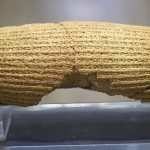A bit of news, connected to today’s lesson. (If you haven’t read the last one, you absolutely must for the proper background to this one.) One of my interests that happens to be both academic and pastoral involves the nature of scripture and inspiration. I’ll be presenting a paper April 8/9 at the Mormon Scholars in the Humanities Conference on “Science, Scripture, and Secularism: Rethinking Some Common Assumptions” which will verge into this territory. I see a spectrum of views about scripture’s inspiration, ranging from “it is a completely human work without any divine inspiration” to “God inspired the very words of the original languages and the KJV English, so that every word is divine.” The first is obviously a very secular view which removes God entirely (“if God even exists,” they might say), and the second renders the humans involved in the process little more than robots, mortal keyboards upon which God typed.
I reject both of these extremes. I reject the first, not because I have any proofs or infallible arguments for God’s existence, but because of personal experience. I reject the latter because it doesn’t coherently fit the data (i.e. scripture, whether the Bible or the larger LDS canon), and because there are better ways of accounting for that data. Many Mormons, it appears, embrace something like the latter in spite of all the statements to the contrary in the Book of Mormon itself; We critique Evangelicals for infallibility and give lip service to fallibility in our own Church, but then…
We don’t have a good working method of dealing with the humanity in our scriptures or our living leaders. And by “we” I don’t mean the hierarchy of the Church, though it would be nice to have something going to the worldwide church. Rather, I mean the people teaching the lessons, sitting in the pews, of your local ward. We kind of default to the “God did it all” view.
I’ve shifted my book slightly to deal with this uncomfortable mixture of the human and divine in scripture, since Genesis 1 is a prime example. The creation described there clearly and unambiguously represents an ancient view, with the sky as a solid dome above a flat earth, with waters above the dome and below the earth. Not a sphere, nor planets rotating around a sun. (If you want to read about ancient cosmology and science, try this book, this one, or this one.) There’s no way to write this off as a minor detail or reconcile it with science; it’s the central thrust of the chapter. It’s also repeated in modern scripture, Moses and Abraham. So how do we deal with inspired scripture that is wrong?
I expand on this greatly in my book, with several different principles. But the short version is, inspired things can be wrong, inconsistent, or uncomfortable. How do we account for it? Not by assuming the human and divine can be neatly separated from each other in scripture; they can’t, really, because God works through the fallen humans, their language, and their culture.
I believe, then that there is a mix of divine and human perspective in all scripture, every book and chapter. Brigham Young agrees with me, or vice-versa 🙂
I do not even believe that there is a single revelation, among the many that God has given to the Church, that is perfect in its fulness. The revelations of God contain correct doctrine and principles so far as they go; but it is impossible for the poor, weak, groveling, sinful inhabitants of the earth to receive a revelation from the Almighty in all its perfections. He has to speak unto us in a manner to meet the extent of our capacities (Brigham Young, July 8 1855, JD 2:314).
(For a much longer, nuanced, multi-pronged argument along these lines, you’ll just have to wait for my book. Sorry.)
How does this play in today? Last week, I talked about the Deuteronomistic background of covenant and especially cursing, in Lehi’s discourse, while also pointing out there was nothing in there about skin or race or whatnot.
That comes in today, in chapter 5. Now, as I’ve pointed out multiple times, everything up to this point in the Book of Mormon has been written from the perspective of decades later.
When they arrive at 2 Nephi 5, readers would do well to return to the first chapter of First Nephi, because the situation of the narrator has finally become clear. Nephi is not recording events as they happen. Instead, he is a middle-aged man recounting incidents from his teens and early twenties, with the full knowledge that life in the Promised Land has soured, that there has been an irreparable breach with his brothers, and that his closest relatives have spent years trying to kill each other. We are reading a second version of his memoirs, based in part on writings of his father and focusing particularly on spiritual matters (as God had commanded in 1 Ne. 9:3–4).28 This information is crucial in trying to sort out the narrator’s attitudes and perspective, but because it is mentioned only in passing much later in the text, few readers of First Nephi realize that their conception of Nephi is still incomplete.
To use the technical language of narratology, the book of First Nephi constitutes an autodiegetic, temporally distant, embedded narrative. That is to say, Nephi relates incidents from his own life, long after the fact, and the main narrative is framed by a more comprehensive story—the story of God commanding Nephi to write a second record, which was an abridgment of his first draft. – Hardy, Understanding the Book of Mormon: A Reader’s Guide (My italics.)
Note that no time passes in 2Ne 1-4. When we get to chapter 5, all kinds of stuff happens, in summary.
Soon after landing, Lehi dies and conflict breaks out between Nephi, Lehi’s successor as prophet, leader, and record-keeper, and his brothers Laman and Lemuel. Nephi leads his people inland several days’ journey, where they become established as a righteous, prosperous people. They build a temple, engage in metalworking and agriculture, and call themselves “Nephites.” Meanwhile, their rivals, soon known by the name “Lamanites” and cursed with darkness, become “an idle people, full of mischief and subtlety” and “a scourge unto [Nephi’s] seed” (2 Nephi 5:24-25). Thus is established the pattern that will dominate much of the millennium-long history to follow, as chronicled by Nephi and other keepers of the sacred records. When recurrent cycles of Nephite prosperity and complacency lead to spiritual blight, wars with the Lamanites intensify, accompanied by prophetic chastisement and repentance. Toward the end of the Nephite record especially, accounts of internal dissension and government corruption multiply, along with detailed narratives of civil war, treacherous defections, and the rise of great robber armies. Brilliant generalship, spiritual reform, and stirring heroism provide brief moments of respite from the advancing tide of cataclysmic destruction.
What prevents the record from falling into a faceless, Calvinist morality play, emphasizing human recalcitrance and the inevitable degeneration of human empires, is the emphatic insistence of Mormon, fourth-century abridger of the Nephite records, that individual choice produces cataclysmic consequences. “Either something or nothing must depend on individual choices,” writes C. S. Lewis, and Mormon, writing at the end of his people’s existence around A.D. 340, embraces the first option. He illustrates the point by describing a period of fragile and hard-won peace during in the first century B.C., in which a single malcontent aspires to kingship. Inciting both spiritual apostasy and political dissent, Amalickiah succeeds in provoking a rebellion that soon engulfs the whole face of the land in years of bitter warfare. “Yea, and we also see,” moralizes Mormon, “the great wickedness one very wicked man can cause to take place among the children of men” (Alma 46:9). – Givens, By The Hand of Mormon: The American Scripture that Launched a New World Religion
So now, Lehi is dead, they’ve separated, probably merged in some sense with locals, and already had some skirmishes. Laman, Lemuel, and those who accept their leadership have largely rejected the covenant Lehi spoke of, and therefore its curse is upon them.
Ancient Israelites, like other ancient worldviews (and many Muslims today) did not distinguish between what we might call natural causality and divine causality. Whatever happened, whether life or death, rain or drought, accident or good fortune, happened because of deity. (See down in the Tidbits, here.) Nephi would have shared this view, and interpreted events around him in that light. Because they had broken the covenant, whatever negative things befell them constituted divine action, carrying through with the curse. Consequently, if their children looked different from the Israelites (as they would, if they intermarried with locals), Nephi would interpret those new physical characteristics as part of the curse. Nephi’s worldview in this respect becomes written in to scripture. This is no different than Genesis 1 reflecting an ancient and different worldview.
This assumes, of course, that Nephi is describing an actual, physical difference, and there is some evidence against that traditional reading, which at minimum greatly complicates it. Here I summarize.
- Nephi uses binary black/white language, but Israelites weren’t “white” and no one in the Americas 2400 years ago was “black,” as far as we know. This is not to say they were physiologically homogenous from north to central to south America; only that the degree of racial distinctions someone would naturally think of in 1830 or 2016 when they hear “black” or “white” would probably not apply.
- If one could distinguish Nephites from Lamanites easily by skin color, then several stories where Nephites pass themselves off as Lamanites (or vice-versa) cease to make sense. Alma 55 is one example.
- Israelite and other ancient Near Eastern texts were “colorist” in the sense that white generally had positive associations (good, clean, pure) and black the inverse… but they don’t ever seem to have applied this to different peoples or nations. It does show up in figurative language applied to humans, however. One more “modern” example would be the Qur’an, which says that in the resurrection, the faces of the righteous will be white, but the faces of the wicked will be black.
(If I have time, or if someone asks in the comments, I can link to some discussion of this by Gardner or others. I just haven’t had time.)
I am not convinced that the traditional understanding of a physical distincation in skin color is accurate, for the reasons above. However, if it was the case that some distinction arose, I don’t see that Nephi attributing that change to the reject-the-covenant-curse makes God responsible for it. That’s Nephi’s ancient worldview in which God is largely responsible for everything beyond human control. This is not rejecting scripture or picking-and-choosing. Rather, to repeat myself, inspired scripture inevitably contains human perspectives and worldview, because inspired humans are writing it. To summarize, I’ll reprint the comment I made on Ardis’ post (link below.)
It’s apparently a fine line for some people between a few options.
Option 1) “The Book of Mormon says it, I believe it, that settles it” an adapted Protestant trope, meaning, anything scripture says comes straight out of the divine omniscient Heavenly Encyclopedia. Thus, if it *seems* problematic, take it up with God.
Any pushback on this idea in general or specific is seen as tantamount to denying prophetic or scriptural authority.
Option 2) “The Book of Mormon isn’t inspired, because racism.” This option assumes that if God *really* inspired scripture, it would represent the height of scientific, moral, ethical, and doctrinal knowledge from beginning to end and be consistent. When scripture fails this yardstick of inspiration, it is judged uninspired.
This assumption, however, is simplistic and unwarranted.
Option 3) Scripture is written by divinely-inspired human hands. Not by God (removing humanity from the process, or making them mere typewriters), and not by humans alone (cutting out inspiration.) This means that scripture often represents human perspectives and culture, which God must work with. Recognizing the limitations God must work with because he chooses to work with humans is not a rejection of scripture, nor entirely a Pandora’s box.
This option, containing nuance and complexity, is the most defensible option as well as the one that best fits all the data we have in scripture. It’s also the one that requires the most mature perspective, and isn’t taught in Primary. And to someone who only understands the options to be #1 and #2, someone teaching #3 sounds like they’re actually teaching #2.
Tidbits:
- The Book of Mormon originally had no punctuation (as is the case with the ancient languages with which I am familiar). When you come to 2Ne 3, it’s often hard to tell who is speaking to whom, because multiple layers are nested within each other, and there are no quotation marks. Kevin Barney takes a look at this here, and Ardis Parshall provides some helpful parsing and layout here. (Kevin comments on Ardis’ post, and then refines/corrects his own post in the comments.)
- I also think Ardis did a bang-up job connecting last week’s lesson to the issue of cursing in 2Ne 5. See here and read the comments as well.
- There is a textual change from “white” to “pure” in 2 Nephi 30:6 which relates. This change was made in 1981, and consequently accusations arose that the Church was changing scripture in order to back away from the idea of literal changes in skin color (which, to be clear, some believed to be the case, such as President Kimball.) However, this change was first made by Joseph Smith in the 1840 edition (see Skousen, p. 245 of the appropriate volume here.) Because of the convoluted printing history, post-1840 editions of the Book of Mormon were printed from the 1837, which means this change did not reenter our text until the Church started doing textual criticism. From a speculative perspective, the Hebrew root lbn may carry the meaning of either “white” or “pure” in certain contexts, e.g. Psalm 51:9. Of this passage, the Theological Dictionary of the Old Testament says “The outward act of washing, which is actually meant to effect ritual purity, is here applied to the removal of sin. In this context, ‘white’ and ‘pure’ are more or less synonymous. The same imagery appears also in Isa. 1:18.”
- On “Nephi’s Psalm” and poetry, see Book of Mormon Central.
If you’d like to read more of my posts touching on the topic of scripture, inspiration, and authority, see
- Faith, Revelation, and Jewish Parallels
- An Offhand Apologia of Sorts and Some Reflections
- On Conflation; Or, Throwing Out the Baby with the Bathwater in 1911 at BYU
- The Old Testament, Scripture, Apostles, the Priesthood Ban, and Theological Diversity: Calibrating Our Expectations
- God, the Necessity of Scholars, and the Old Testament
As always, you can support my work through making your regular Amazon purchases through this Amazon link. Or you can donate directly here.
You can also get updates by email whenever a post goes up (subscription box on the right). If you friend me on Facebook, please drop me a note telling me you’re a reader. I tend not to accept friend requests from people I’m not acquainted with.












